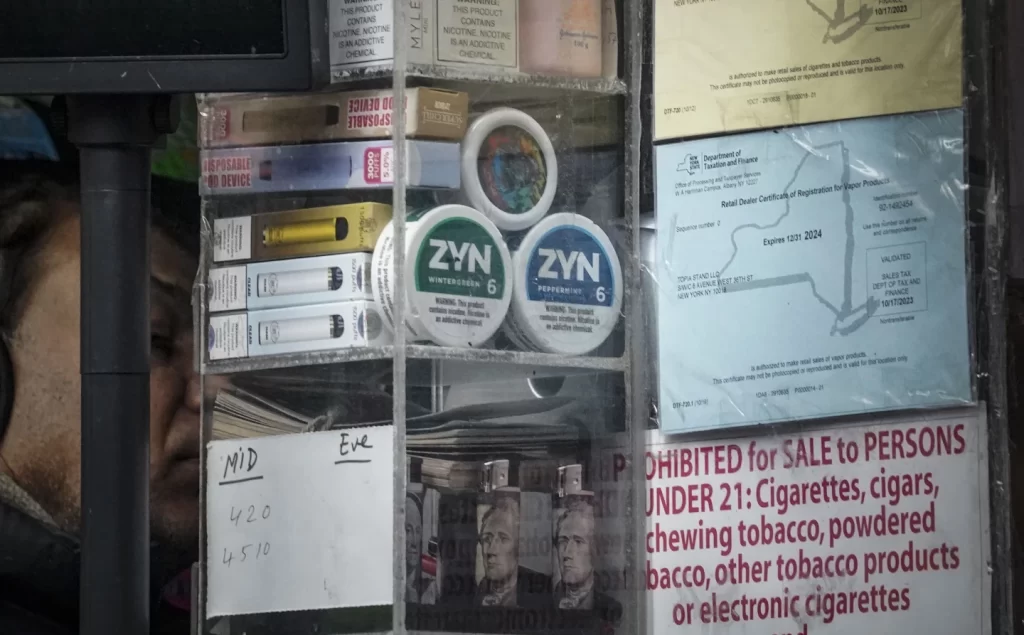
WASHINGTON — There’s nothing complicated about the latest tobacco product trending online: Zyn is a tiny pouch filled with nicotine and flavoring.
But it has stoked a debate among politicians, parents and pundits that reflects an increasingly complex landscape in which Big Tobacco companies aggressively push alternative products while experts wrestle with their potential benefits and risks.
Zyn comes in flavors like mint, coffee and citrus, and Philip Morris International markets it to adult tobacco users. But videos of young people popping the pouches have racked up millions of views on TikTok and other social media platforms.
That trend has advocates worried that Zyn could become the latest nicotine product to attract underage teens, similar to the way Juul triggered a yearslong spike in vaping. Other experts say that risk is outweighed by the potential to steer adults away from cigarettes and other traditional tobacco products, which account for 480,000 U.S. deaths annually.
“The definition of insanity is doing the same thing and expecting a different result,” said Dr. Jasjit Ahluwalia, an addiction specialist at Brown University. “That is what we’ve done with tobacco for decades. We’ve been all about abstinence, instead of embracing products that can reduce harm.”
Ahluwalia sees nicotine pouches and e-cigarettes as a way to help smokers cut back or quit cigarettes.
That approach is standard practice in the U.K., but it’s outside the medical mainstream in the U.S., where only pharmaceutical-grade medications like nicotine gum and lozenges are formally approved to help smokers quit.
Ahluwalia points out that Zyn works the same way as those products: releasing low levels of nicotine that are absorbed into the gums, reducing cravings. The chief difference, he notes, is that Zyn is sold by Philip Morris, the global cigarette giant and a longtime foe of anti-smoking groups.
Conservative pundit Tucker Carlson, a Zyn user, jumped into the fray, declaring: “Zyn is not a sin,” and touting its unproven benefits, like “enhancing male vitality and mental acuity.”
Zyn users have quickly developed their own online vocabulary, including “zynnies,” “zynner” and “zynsky.”
Online videos show young people documenting their first experiences trying Zyn, reviewing different flavor combinations and displaying heaping piles of used canisters.
“It’s concerning to see the countless Zyn-related memes and hashtags that are being amplified and normalized across social media,” said Kathy Crosby, CEO of the Truth Initiative, an anti-tobacco advocacy group.
Truth and other groups point to research suggesting nicotine can interfere with brain development in adolescents.
It’s the Food and Drug Administration’s job to weigh Zyn’s risks to youngsters against its potential to help adults.
In a statement, an FDA spokesman said the agency is monitoring underage use, noting that 1.5% of high school and middle schoolers reported using pouches last year. That’s well below the 10% who used e-cigarettes.
FDA officials have allowed Zyn to stay on the market while they review Philip Morris’ marketing application, which has been pending since 2020. If teen use remains low, the company could win FDA authorization for at least some of its offerings, which come in multiple strengths and a dozen flavors.
In 2019, the FDA awarded its first-ever reduced risk designation to a similar product: snus, a tobacco pouch popular in Sweden that contains lower levels of carcinogens than cigarettes. The FDA said smokers who switch to snus reduce their risk of lung cancer, bronchitis and other diseases.
Zyn excludes the tobacco leaves found in snus, leaving only nicotine, which Philip Morris says increases its appeal.
“People can be reluctant to move into an oral tobacco product if they view it as similar to traditional chewing tobacco,” company spokesman Corey Henry said. “Consumer acceptability is a big part of Zyn.”
Philip Morris doesn’t use online influencers or endorsements to promote Zyn, Henry said. Its website is restricted to adults 21 and older. And flavors like cinnamon and peppermint are “familiar to adults,” Henry said.
Zyn launched in the U.S. in 2014, but sales have exploded in the past year, generating $1.8 billion as shipments accelerated year-over-year by over 60%.
On a November call with retailers, one company executive called the growth “gonzo” and “lights out.”
“I didn’t see this coming. I don’t know anyone who did,” said Joseph Teller, a director for oral tobacco products.
Zyn promotions emphasize the pouches’ discreet, convenient nature as a “smoke-free,” “spit-free” alternative for smokers “at work” or “on the move.”
But to fulfill the company’s stated goal of a “smoke-free future,” Zyn will need to help users fully switch from cigarettes, rather than alternating between the two.
There’s little data on switching, and preliminary research suggests pouches may not be a great substitute.
Ohio State University researchers recently found it took smokers 30 minutes to an hour to get enough nicotine from Zyn to relieve their cravings. With cigarettes, smokers achieved the same nicotine levels — and relief — in five minutes.
“The pouches we studied, especially the lower nicotine concentrations, did not appear to meet the needs of smokers,” said Brittney Keller-Hamilton, who led the study. “That being said, they didn’t totally flop either.”
For now, smokers who have had success with Zyn say they hope it stays available.
Justin Wafer, 39, was smoking a pack a day last spring while working as a bartender in Portland, Oregon. On busy days, he would also vape if he didn’t have time to step away for a smoke break.
But after his reloadable electronic cigarette broke in May, he decided to try Zyn. These days, he usually pops a pouch every three to four hours and says he hasn’t smoked in more than nine months.
“I don’t see how it’s any different from pharmaceutical solutions like lozenges or gum,” he says. “Except it’s easier to get and tastes better.”





